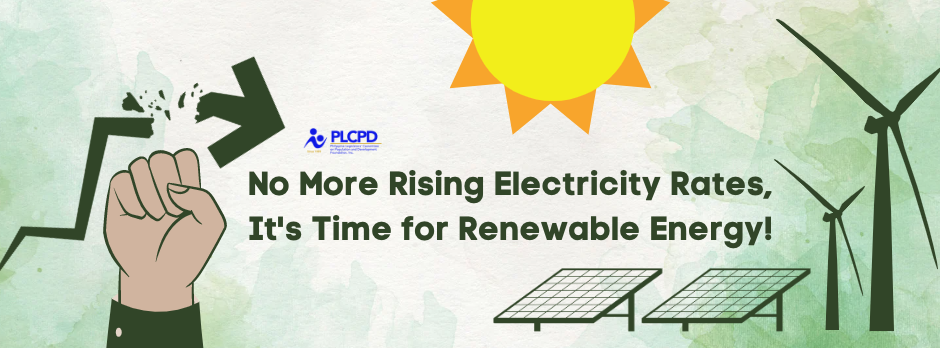No More Rising Electricity Rates, It’s Time for Renewable Energy!

Last month, Meralco implemented another electricity price hike amid worsening inflation. The increase applied was P0.6232 per kWh, an additional P125 in the monthly bill for an ordinary household consuming 200 kWh.
This is consistent with the previous price hikes in 2022, like the one in November with the increase of P0.844 per kWh, equivalent to P17 for a household that consumed 200 kWh, and in December, with P0.3297 per kWh or 66 pesos for 200 kWh). The increase was triggered by the increased charges of more expensive fuel used by Independent Power Producers (IPP) and the rising of wholesale electricity spot market prices due to tight supply conditions that caused preceding yellow alerts, particularly in the Luzon grid.
Similar to the red onion price hike also caused by excessive importation plus the persistence of illegal smuggling, electricity is definitely one of the top concerns of all Filipinos.
Filipino families that belong to poor households and only earn a minimum wage of P570 per day (Metro Manila rate), this is an additional struggle to survive the daily expenses. Even when prices of basic commodities, products, and services continue to increase, wages remain low. Worse, the minimum wage all over the country is still disproportionate and does not even reach 50-60% of the living wage.
Home-based workers suffer as they heavily rely on electricity as their capital to perform their jobs. Businesses, especially micro, small and medium enterprises too, are affected as they consume more electricity compared to an ordinary household.
Furthermore, transportation costs aggressively increased as prices of diesel, gasoline, and petroleum skyrocketed. This alone has emptied the pockets of daily commuters who go to work or school as they had to spend more on transportation. Not to mention that our country is heavily dependent on imported petroleum, and despite available options to switch to alternative sources of energy such as solar or wind to avoid the volatility of the petroleum prices -and reduce transport costs, the government is yet to act on it. So what’s stopping us from transitioning to greener, more cost-efficient, and sustainable energy systems?
The real issue behind the worsening power crisis: Importation, importation, importation
For the longest time, our country’s energy sources have been heavily dependent on fossil fuels: coal, oil, and gas (natural gas), which are non-renewable sources that continue to harm our planet. Fossil-fueled power plants emitting large carbon emissions intoxicate our air and thin the ozone layer, causing more health and environmental impacts.
On top of that, almost half of the fossil fuel supply except for gas is imported, which is why it costs more. As independent power producers (IPP) and electric cooperatives continue to rely on costly imported coal and crude oil, the electricity rates will continue to skyrocket and the burden will always fall on the end-users.
Another threat is looming. With the Malampaya natural gas plant, which covers 40% of Luzon’s energy supply, closing for 15-day maintenance next month, consumers need to brace for more electricity price hikes.
Each time we experience a power outage or price hike, Meralco would remind consumers to conserve energy. While this practice is an immediate aid, it is not a long-term solution. In order to solve the existing power crisis, there is a need to break the cycle of the relentless importation and utilization of fossil fuels.
It is time to break our relationship with fossil fuel industries. More sustainable resources are already within our reach, yet we fail to explore and diversify our energy sources. There are existing initiatives and proposals such as solar, wind, and geothermal power that can actually help decrease the electricity rates of end-users and hasten our transition to renewable energy.
Together with advocates of renewable energy, PLCPD calls for our country’s full transition to renewable energy sources. We call on our legislators to pass bills that expand opportunities to implement RE projects, such as improving the net metering program, establishing solar rooftop programs, and institutionalizing the Green Energy Auction Program. It is time to modernize our grids to effectively install and distribute RE. But scaling up clean energy financing is crucial to make this possible.
As an immediate response to the impact of electricity price hikes, government subsidies should be also provided to aid poor households who are gravely affected by rising electricity rates. Finally, we call on the electric cooperatives, independent power producers, and big energy corporations to divert their resources to renewable energy, and more importantly, empower end-users to avert the power crisis through increased participation in the energy transition.
